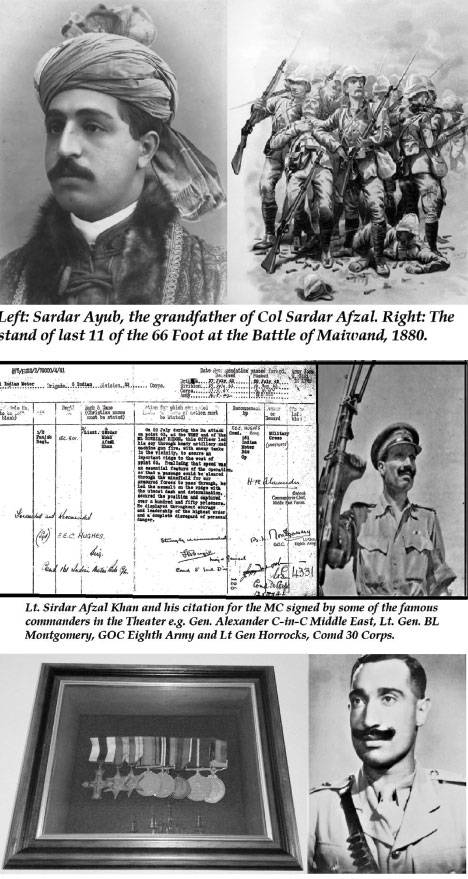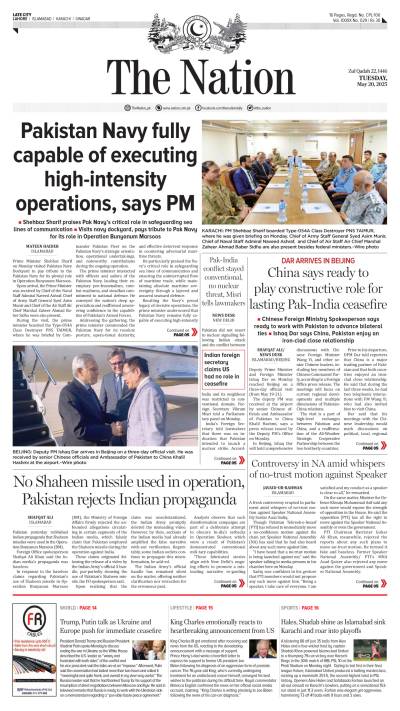In 1880, a military legend was borne on the dusty plains east of Helmand by the rear-guard of the 66 Foot and the stand at Maiwand of its last eleven soldiers who perished in a final charge. The architect of the British defeat was Sardar Ayub, the Emir of Afghanistan who was subsequently deposed and travelled to India in exile with his eleven wives, fifteen sons and ten daughters. One of his grandsons and famous polo player Brigadier Sardar Hissam el Effendi, wore a ring presented by Queen Victoria to Sardar Ayub inscribed with the message—enemy to enemy; friend to friend.
Another grandson of the Emir, Colonel Sardar Afzal Khan of the 1//2nd Punjabis and the Guides Infantry, settled in UK. When the Berkshire Regiment, the successor of the 66 Foot celebrated the centenary of Maiwand, they invited the colonel and his wife. The colonel was a distinguished soldier. Whereas General ‘Bob’ Roberts (later C-in-C India) had defeated his ancestor at the Battle of Kandahar, Afzal fought bravely with the Commonwealth Troops and General Auchinleck, the last C-in-C India, awarded him with the Military Cross. History has some interesting twists to it.
Sardar Afzal was a late entry into the army. Born in 1911 in Dehradun, where some members of Sardar Ayub’s family had been settled, he obtained an Emergency Commission in 1941 at the age of 30 years. He was posted to 1/2nd Punjabis which is the senior most battalion of the Indian Army. Its predecessors were raised during the Carnatic Wars and the regiment was awarded the insignia of a galley, because by 1824 it had fought in eight overseas campaigns. At the early stages of the Second World War, it was part of the 5 Indian Division, the first formation of the Indian Army to sail for Africa. It battled the Italians during the Eritrean Campaign before being thrust into North Africa against the Afrika Corps. In April 1942, the 1/2nd with its parent 161st Infantry Brigade had returned to Egypt from Cyprus where it had been garrisoned against a German invasion and was reorganised as a motor brigade for the First Battle of Alamein.
The battle began with the Axis Forces attempting to break through the line of ‘defensive boxes’ to enter Egypt and decisive battles were fought on and around the vital high ground of Ruweisat Ridge that lay between the Qattara and Alamein Boxes. ‘The Tiger Kills’, a history of the Indian Divisions in North Africa, described the ridge as a ‘…… narrow tongue of land …. [that] gradually emerges as a peninsula of high ground ….. at the rear of the Alamein position ….. [and] ends abruptly in a bluff …… whose crest commands the gap……’ to the sea. 15 Kilometres to its west was the Alam Halfa Ridge where the German armor was decimated a month and a half later during the Second Battle of Alamein.
For 15 days, Rommel’s forces tried valiantly to break through but they were exhausted after the long pursuit and far from their logistic bases. On 15 July the Eighth Army rebounded and attacked to capture the western end of Ruweisat Ridge in an attempt to divide the Axis Forces and engineer a breakout. This first attack has been described in an article on another recipient of the Military Cross—Lt Col Mian Khan, Rajputana Rifles that was published by the Friday Times in their edition of 23 August 2019. It was partially a success and spurred on by Churchill, Lieutenant General Auchinleck, Commander of the Eighth Army launched another assault on 22 July. The 5th Indian Division attacked along Ruweisat Ridge towards Deir El Shein and the New Zealand Division along the western end of the ridge towards the El Mreir Depression. Opposing them were the Italian Brescia Division in Deir el Shein and the 21st Panzer Division on the western end of the ridge.
The attack by the 5th Indian Division was spearheaded by the 161 Indian Motor Brigade which had joined the Division on 18 July. This fresh attack against the center of the enemy’s line was designed to make a breach through which the 23rd Armoured Brigade could pass to sever the line of communication, force him to extend his front and disperse his reserves. Having achieved this, it would roll up the northern part of his force operating towards the coast. At last light on 21 July, the brigade advanced along Ruweisat Ridge, while the 6th New Zealand Brigade attacked northwards across the El Mreir Depression.
In The Three Battles of El Alamein, recently published in Italy in 2019, a very detailed account of the battle is presented, especially from the perspective of the Axis Powers. It shows the exact location of the German and Italian defenses and the progress of the assault. 161 Motor Brigade attacked with all three battalions but the right two battalions made no headway. Brigadier Kippenberger who was commanding the adjoining New Zealand brigade had this to say about one of the nearer battalions. “The advance developed smoothly for about a mile. It brought to mind one from 1916, with the waves that followed one another well aligned. Then it was halted by heavy fire…… The men remained standing defenseless for a few minutes, then the whole mass started running back”. This may have been the 1/1st Punjab, General Auchinleck’s parent battalion, but it wasn’t Afzal’s battalion, the 1/2nd Punjab which broke through and headed towards Hill 63 on the Ruweisat Ridge.
Though 30 years old, Sardar Afzal was only a 2nd lieutenant with one year of service when he led his company into the attack—compensating for his lack of experience with his age. In my research on the British India Army, his is one of the shortest citations that I have seen for a Military Cross.
“On 22 July during the Battalion’s attack on Point-63, at the west end of the El Ruweisat Ridge, this officer led his company through heavy artillery and machine gun fire, with the enemy tanks in the vicinity, to secure an important ridge to the west of Point-63.
Realising that speed was an essential feature of the operation, so that a passage could be cleared through the minefield for our armoured forces to pass through, he led the assault on the ridge with the utmost dash and determination, secured the position, and captured over a hundred and fifty prisoners. He displayed courage and leadership of the highest order and a complete disregard of personal danger”.
Capitalising on the initial success, the Sappers and Miners of the 2nd Field Company assisted by the New Zealanders, began to clear the minefield. Though it was a very difficult task under continuous fire, by early morning a narrow gap had been created and the British 23rd Armoured Brigade started passing through at 8 a.m. Exploiting the entry of armour, the 1/2nd Punjabis renewed the pressure against Hill 63 and was able to take the German position and capture 190 prisoners. Unfortunately, the armoured brigade was directed southwards under the assumption that the zone was free of mines and in the first minefield it lost 30 tanks. The German 5th and 8th Panzer Regiments then counter-attacked forcing Afzal’s battalion to withdraw and Brigadier Kippenberger brigade was disastrously overrun by German tanks. The British 23 Armoured Brigade was also evicted with tremendous casualties, losing 132 of their number during the day against the loss of just three of the enemy.
The 161 Brigade subsequently left India and onto Burma but 1/2nd Punjab served in Egypt and later in Italy. However, there is no information on Sardar Afzal except that at the end of the war he was a temporary major. At Independence his family migrated to Pakistan from Dehradun and Sardar Afzal opted for the Pakistan Army along with his brother Sardar Ismail who was enrolled in the Punjab group but subsequently transferred to the Army Service Corps and retired as a brigadier.
On promotion, Sardar Afzal commanded the Guides Infantry and moved with the battalion to serve in East Pakistan. His son Sardar Haroon based in the UK remembers his father as a thorough gentleman, a man of principles, very humble, kind and brave. It was because of these qualities that the soldiers were close to rebelling when he was posted out as an instructor to the Command & Staff College in Quetta. Col Afzal was a good friend of my father and in fact, my interest in the colonel was initiated by his obituary that appeared in the Daily Telegraph, UK that I found in my father’s papers. From it I learnt that after staff college he commanded Zhob Militia and following his retirement in 1958, he was the director of administration of the Central Treaty Organization in Ankara. He eventually emigrated to the UK in his Sixties and passed away in April 1991 at the age of 79.
Acknowledgements: I am grateful to Sushil Talwar for his generosity in sharing with me the citation and photograph of Col Afzal. I am also grateful to Leila Ismail d/o of Col Sardar Ismail for helping me contact Sardar Haroon, the son of Col Sardar Afzal in the UK who shared memories of his father as well as photographs that have been included in the article.
Tuesday, May 20, 2025
From Miawand to El Alamein: Colonel Sardar Afzal Khan, MC

Major General Syed Ali Hamid
DPM Dar, Chinese FM hails all-weather strategic cooperative partnership
8:43 PM | May 20, 2025
FIA cracks down on Gujranwala passport scam, nabs 14 agents
4:44 PM | May 20, 2025
Govt reviews monsoon preparedness amid rising flood risks
4:36 PM | May 20, 2025
Ahsan Iqbal,CM Bugti discuss development projects
4:33 PM | May 20, 2025
-
Lahore emerges among safest global cities in Numbeo 2025 index
-
Lahore emerges among safest global cities in Numbeo 2025 index
-
India’s suspension of Indus Water Treaty legally baseless
-
Seventh polio case reported in Pakistan amid nationwide vaccination drive
-
Pakistan reports sixth polio case of 2025
-
PTA begins issuing VPN licences to regulate usage
The Wider War
May 20, 2025
Margalla on Fire
May 20, 2025
Defeated and Depressed
May 20, 2025
Regional Reset
May 19, 2025
Peak Potential
May 19, 2025
Worse than Anarchy
May 20, 2025
Salute to our Air Force
May 20, 2025
An Unbreakable Wall
May 20, 2025
Profiteering Milk
May 20, 2025
Rewriting the Rules
May 20, 2025
ePaper - Nawaiwaqt
Nawaiwaqt Group | Copyright © 2025





